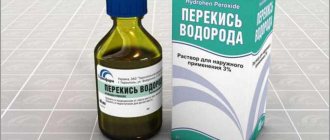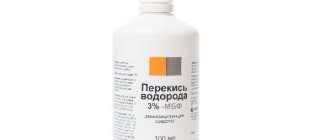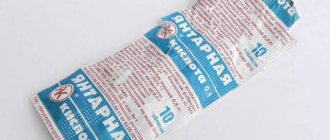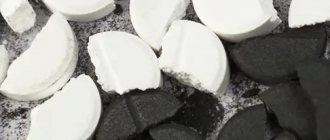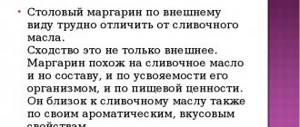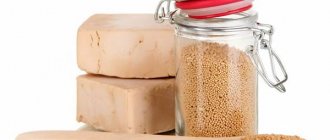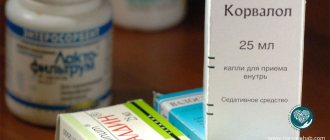Hydrogen peroxide is an absolutely environmentally friendly substance. It is odorless, tasteless and colorless. When it enters a liquid, it breaks down into oxygen and water. In addition, hydrogen peroxide can be safely called a close relative of water, since it has a very similar chemical formula. Their differences lie in only one oxygen atom - H2O2 (water - H2O). This chemical element can hardly be called superfluous, because it is what gives hydrogen peroxide its beneficial properties.
Useful properties and benefits of hydrogen peroxide for the body
- has antiseptic and antibacterial properties,
- has a deodorizing effect,
- cancer prevention,
- cleanses the body of toxins,
- eliminates sinusitis and runny nose,
- treats diseases of the respiratory system,
- helps with sore throat,
- alleviates the condition of osteochondrosis,
- slows down the aging process,
- improves skin condition,
- heals minor skin damage (abrasions, scratches),
- stops minor bleeding
- eliminates ear and toothaches,
- treats stomatitis (by rinsing),
- is an environmentally friendly substance,
- accelerates plant growth.
Contraindications and harm
- individual intolerance,
- the presence of transplanted organs,
- problems with the pancreas,
- atherosclerosis,
- ulcer and gastritis,
- diabetes.
There has always been a lot of controversy about the use of hydrogen peroxide as a remedy. Many admire its effect, while others are afraid. This is due to the fact that taking the solution orally is fraught with bad consequences - burns of the esophagus, poisoning, the formation of ulcers and erosions. If the solution gets into the respiratory tract, mucous membrane or skin, it can also cause a burn.
In addition, hydrogen peroxide can cause allergic reactions, nausea, vomiting, diarrhea, weakness and even insomnia.
If you decide to resort to treatment with this remedy, then you should be very careful. Use the solution in small quantities and ALWAYS dilute with water when ingesting as it is very dangerous in concentrated form.
The daily dosage of hydrogen peroxide according to W. Douglas is 30 drops per day in 3 divided doses.
It is used to treat many diseases and in everyday life. It is also a component of nourishing and whitening face masks.
Treatment with hydrogen peroxide. How to use
Use a 3% solution.
For sore throat. 1 tsp substances + 3 tbsp. Mix the water well. Gargle with the resulting solution. The number of repetitions per day is 3-4. Please note that you should rinse no more than once every 3 hours.
After the procedure, be sure to rinse your mouth with another solution. This is done to remove foam in which infections have accumulated.
For sinusitis and runny nose. 15 drops of the substance + 1 tbsp. water. Using a pipette, rinse your nose with the product.
From periodontal disease. 20 drops of solution + 3 g of soda + 10 drops of lemon juice. Brush your teeth as usual, and then rinse your mouth with the mixture. After the procedure, you should not eat or drink for 20-30 minutes.
For ear pain. Place 4 drops in each ear.
Treatment of wounds and bruises with hydrogen peroxide. 3 tsp + 3 tbsp. water. Soak a cotton napkin in the mixture and apply to the problem area of the skin. Secure the compress with a bandage or plaster. Leave it for 60 minutes. Then remove it and wipe the wound with the solution.
From osteochondrosis. The previous method will do. You just need to cover the compress with a bag.
Use of the drug
Initially, H2O2 was used exclusively for cardiovascular diseases. Afterwards, it was discovered that they can cure emphysema, bronchitis and allergies. The drug has medicinal properties that can destroy cancer cells, remove fats from the walls of blood vessels and treat leukemia.
Today, the solution is a huge success. It is sold in every pharmacy without a doctor's prescription and is widely used in medicine. For example, depending on the concentration, it acts bactericidal (0.5-3%), bacteriostatic (0.2-0.3%), on all kinds of microorganisms and has a deodorizing effect. At high concentrations (more than 30%), it causes local irritation, and causes depigmentation on the skin and mucous membranes. This mechanism of action is explained as follows: upon contact with tissues, under the influence of the contained catalase enzymes, the solution rapidly decomposes and releases molecular oxygen, which oxidizes the organic substances of various cells.
Using hydrogen peroxide at home
Hydrogen peroxide in the kitchen
1. Peroxide perfectly helps to disinfect cutting boards and other surfaces, kills germs that are dangerous to health - salmonella and coca bacteria.
2. For disinfection, when cleaning the kitchen, remember a simple rule - spray the kitchen boards first with a 3% solution of hydrogen peroxide, and then with table vinegar. After this, wash the boards thoroughly with tap water and dry.
3. Wipe the work surface in the kitchen with a rag, after moistening it with peroxide.
4. If you use a dishwasher, then when washing dishes, add 50 ml of peroxide in addition to the main product. It will greatly improve the quality of washing, and the dishes will shine like new.
In the bathroom and toilet
1. In the bathroom, peroxide will help get rid of mold and prevent its reoccurrence. To do this, you need to take a 33-35% solution, mix it with water in equal proportions, and then spray the moldy surfaces with a spray bottle.
2. A solution of hydrogen peroxide and ammonia will also help get rid of rust stains and stains in the bathroom and on other surfaces. Take 2 of these components in equal parts and moisten a rag with the resulting solution and wipe the areas where there are stains and rust.
3. In order to disinfect and thoroughly wash the toilet, you need to take 2 liters of water, 1 glass of hydrogen peroxide, 1 tbsp. ammonia. Pour the resulting solution inside, lower the lid, let it sit for 10 minutes, then clean it with a brush.
4. If the walls of the bathroom are covered with water-based paint or tiled, it is necessary to periodically spray them with a 3% peroxide solution heated to 40-50°C.
5. Use hydrogen peroxide to bleach clothes: add peroxide to hot water with powder and put the clothes in and let them sit. It’s better, of course, to boil it, but nowadays we often don’t have time for that, but it’s not scary, and without boiling it whitens and disinfects well.
Professor Neumyvakin's method
Neumyvakin Ivan Pavlovich is a promoter of treatment with hydrogen peroxide. He developed a universal scheme for its use, with the help of which almost all diseases are cured. This technique should be started with 1 drop of solution and increased daily to 10 drops, which are taken orally for 10 days three times a day. Afterwards, take a 3-day break and the procedure can be repeated. All doses of H2O2 (from 1 to 10 drops) are diluted with 50 ml of clean water. The procedures can be continued indefinitely.
Such treatment can cause unpleasant sensations that cause discomfort to the human body: sweating, burning in the stomach or pulsation. Then you will need to reduce the number of drops you take for a few days, or stop them altogether until the unpleasant symptoms disappear completely.
Receipt
Historically, the first industrial method for the synthesis of hydrogen peroxide was the electrolysis of sulfuric acid or a solution of ammonium sulfate in sulfuric acid, during which peroxodisulfuric acid is formed, followed by hydrolysis of the latter to peroxide and sulfuric acid:
H 2 S 2 O 8 + 2 H 2 O → H 2 O 2 + 2 H 2 SO 4 {\displaystyle {\mathsf {H_{2}S_{2}O_{8}+2H_{2}O\rightarrow H_ {2}O_{2}+2H_{2}SO_{4}}}}
Since the mid-20th century, the persulfate process for the synthesis of hydrogen peroxide has been replaced by the anthraquinone process, developed by BASF in the 1930s[2]. This process formally involves the oxidation of hydrogen by atmospheric oxygen with catalysis by alkyl derivatives of anthraquinone:
The process is based on the auto-oxidation of alkyl anthrahydroquinones (usually 2-ethyl, 2-tert-butyl and 2-pentyl anthrahydroquinones) with atmospheric oxygen to form anthraquinones and hydrogen peroxide. The reaction is carried out in a solution of alkylanthrahydroquinones in benzene with the addition of secondary alcohols; upon completion of the process, hydrogen peroxide is extracted from the organic phase with water. To regenerate the starting anthrahydroquinones, a benzene solution of anthraquinones is reduced with hydrogen in the presence of catalytic amounts of palladium[3].
Hydrogen peroxide can also be obtained by catalytic oxidation of isopropyl alcohol [4]:
( CH 3 ) 2 CHOH + O 2 → ( CH 3 ) 2 CO + H 2 O 2 {\displaystyle {\mathsf {(CH_{3})_{2}CHOH+O_{2}\rightarrow (CH_{3 })_{2}CO+H_{2}O_{2}}}} ,
Acetone is a valuable by-product of this reaction, but this method is not currently used on a large scale in industry.
In laboratory conditions, the following reaction is used to produce hydrogen peroxide:
B a O 2 + H 2 SO 4 → B a SO 4 ↓ + H 2 O 2 {\displaystyle {\mathsf {BaO_{2}+H_{2}SO_{4}\rightarrow BaSO_{4}\downarrow +H_ {2}O_{2}}}}
Concentration and purification of hydrogen peroxide is carried out by careful distillation.
Recently (late 20th century) it was possible to synthesize H2O3 and H2O4. These compounds are very unstable. At ordinary temperatures (at normal temperatures) they decompose in a fraction of a second, but at low temperatures of about −70 °C they exist for hours. Spectrochemical study shows that their molecules have a zigzag chain structure (similar to sulfanes): H—O—O—O—H, H—O—O—O—O—H.[5]
Biological properties
Hydrogen peroxide is a reactive form of oxygen and, when produced in excess in the cell, causes oxidative stress. Some enzymes, such as glucose oxidase, produce hydrogen peroxide during the redox reaction, which can play a protective role as a bactericidal agent. Mammalian cells do not have enzymes that reduce oxygen to hydrogen peroxide. However, several enzyme systems (xanthine oxidase, NADP•H oxidase, cyclooxygenase, etc.) produce superoxide, which is converted spontaneously or under the action of superoxide dismutase to hydrogen peroxide.
Redox properties
Hydrogen peroxide has oxidizing as well as reducing properties. It oxidizes nitrites into nitrates, releases iodine from metal iodides, and breaks down unsaturated compounds at the site of double bonds. Hydrogen peroxide reduces gold and silver salts, as well as manganese, when reacting with an aqueous solution of potassium permanganate in an acidic environment.
When H2O2 is reduced, H2O or OH- is formed, for example:
H 2 O 2 + 2 KI + H 2 SO 4 → I 2 + K 2 SO 4 + 2 H 2 O {\displaystyle {\mathsf {H_{2}O_{2}+2KI+H_{2}SO_{4 }\rightarrow I_{2}+K_{2}SO_{4}+2H_{2}O}}}
When exposed to strong oxidizing agents, H2O2 exhibits reducing properties, releasing free oxygen:
O 2 2 − → O 2 + 2 e − {\displaystyle {\mathsf {O_{2}^{2-}\rightarrow O_{2}+2e^{-}}}}
For example:
3 H 2 O 2 + 2 KM n O 4 → 2 M n O 2 + 2 KOH + 3 O 2 ↑ + 2 H 2 O {\displaystyle {\mathsf {3H_{2}O_{2}+2KMnO_{4} \rightarrow 2MnO_{2}+2KOH+3O_{2}\uparrow +2H_{2}O}}}
The reaction of KMnO4 with H2O2 is used in chemical analysis to determine the H2O2 content:
5 H 2 O 2 + 2 KM n O 4 + 3 H 2 SO 4 → 5 O 2 + 2 M n SO 4 + K 2 SO 4 + 8 H 2 O {\displaystyle {\mathsf {5H_{2}O_{ 2}+2KMnO_{4}+3H_{2}SO_{4}\rightarrow 5O_{2}+2MnSO_{4}+K_{2}SO_{4}+8H_{2}O}}}
It is advisable to carry out the oxidation of organic compounds with hydrogen peroxide (for example, sulfides and thiols) in acetic acid.
Chemical properties
Both oxygen atoms are in the intermediate oxidation state −1, which determines the ability of peroxides to act as both oxidizing agents and reducing agents. Their most characteristic oxidizing properties are:
N a 2 SO 3 + H 2 O 2 → N a 2 SO 4 + H 2 O {\displaystyle {\mathsf {Na_{2}SO_{3}+H_{2}O_{2}\rightarrow Na_{2} SO_{4}+H_{2}O}}} M n ( OH ) 2 + H 2 O 2 → M n O ( OH ) 2 + H 2 O {\displaystyle {\mathsf {Mn(OH)_{2 }+H_{2}O_{2}\rightarrow MnO(OH)_{2}+H_{2}O}}}
When interacting with strong oxidizing agents, hydrogen peroxide acts as a reducing agent, oxidizing to atomic oxygen:
2 A g NO 3 + H 2 O 2 → 2 A g + 2 O + 2 HNO 3 {\displaystyle {\mathsf {2AgNO_{3}+H_{2}O_{2}\rightarrow 2Ag+2O+2HNO_{3 }}}}
The hydrogen peroxide molecule is highly polar, which results in hydrogen bonds between the molecules. The O-O bond is weak, so H2O2 is an unstable compound and easily decomposes. The presence of transition metal ions may also contribute to this. In dilute solutions, hydrogen peroxide is also unstable and spontaneously disproportions into H2O and O. The disproportionation reaction is catalyzed by transition metal ions and some proteins:
2 H 2 O 2 → 2 H 2 O + O 2 {\displaystyle {\mathsf {2H_{2}O_{2}\rightarrow 2H_{2}O+O_{2}}}}
However, very pure hydrogen peroxide is quite stable.
Hydrogen peroxide exhibits weak acidic properties (K = 1.4 10−12), and therefore dissociates in two steps:
H 2 O 2 ⇄ H + + HO 2 − ; HO 2 − ⇄ H + + O 2 2 − {\displaystyle {\mathsf {H_{2}O_{2}\rightleftarrows H^{+}+HO_{2}^{-};~~~~~~HO_ {2}^{-}\rightleftarrows H^{+}+O_{2}^{2-}}}}
When a concentrated solution of H2O2 acts on some hydroxides, in some cases metal peroxides can be isolated, which can be considered as salts of hydrogen peroxide (Li2O2, MgO2, etc.):
H 2 O 2 + 2 N a OH → N a 2 O 2 + 2 H 2 O {\displaystyle {\mathsf {H_{2}O_{2}+2NaOH\rightarrow Na_{2}O_{2}+2H_{ 2}O}}} H 2 O 2 + B a ( OH ) 2 → B a O 2 ↓ + 2 H 2 O {\displaystyle {\mathsf {H_{2}O_{2}+Ba(OH)_{ 2}\rightarrow BaO_{2}\downarrow +2H_{2}O}}}
Hydrogen peroxide can exhibit both oxidizing and reducing properties. For example, when interacting with silver oxide, it is a reducing agent:
H 2 O − 1 2 + A g 2 O ⟶ 2 A g + O 0 2 + H 2 O {\displaystyle {\mathsf {H_{2}{\stackrel {-1}{O}}_{2}+ Ag_{2}O\longrightarrow 2Ag+{\stackrel {0}{O}}_{2}+H_{2}O}}}
In the reaction with potassium nitrite, the compound serves as an oxidizing agent:
KNO 2 + H 2 O − 1 2 ⟶ KNO − 2 3 + H 2 O {\displaystyle {\mathsf {KNO_{2}+H_{2}{\stackrel {-1}{O}}_{2}\ longrightarrow KN{\stackrel {-2}{O}}_{3}+H_{2}O}}}
The peroxide group [—O—O—] is found in many substances. Such substances are called peroxides or peroxide compounds. These include metal peroxides (Na2O2, BaO2, etc.). Acids containing a peroxide group are called peroxoacids, for example, peroxomonophosphoric acid H3PO5, peroxodisulphuric acid H2S2O8 and peroxonitric acid HNO4.
